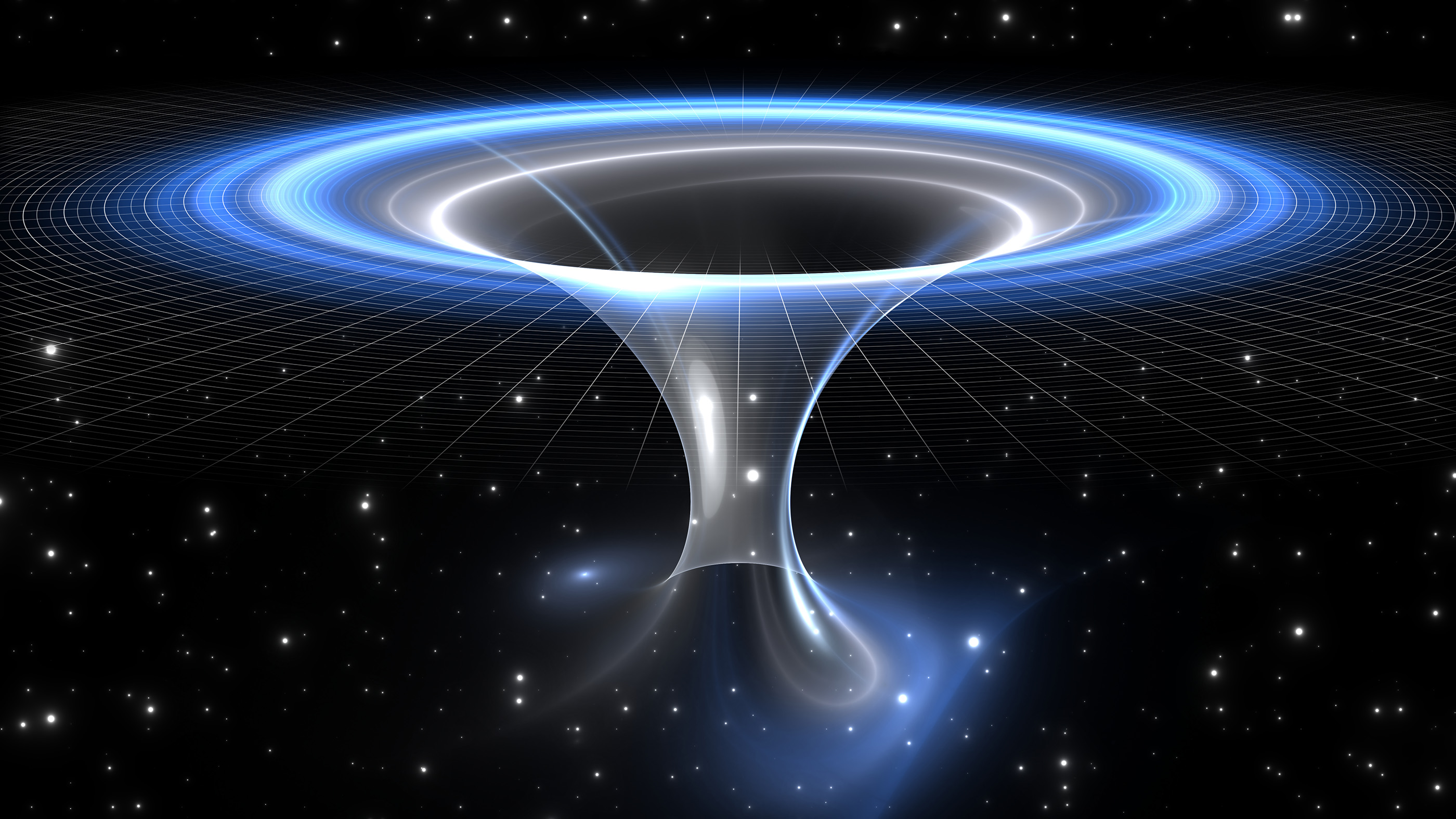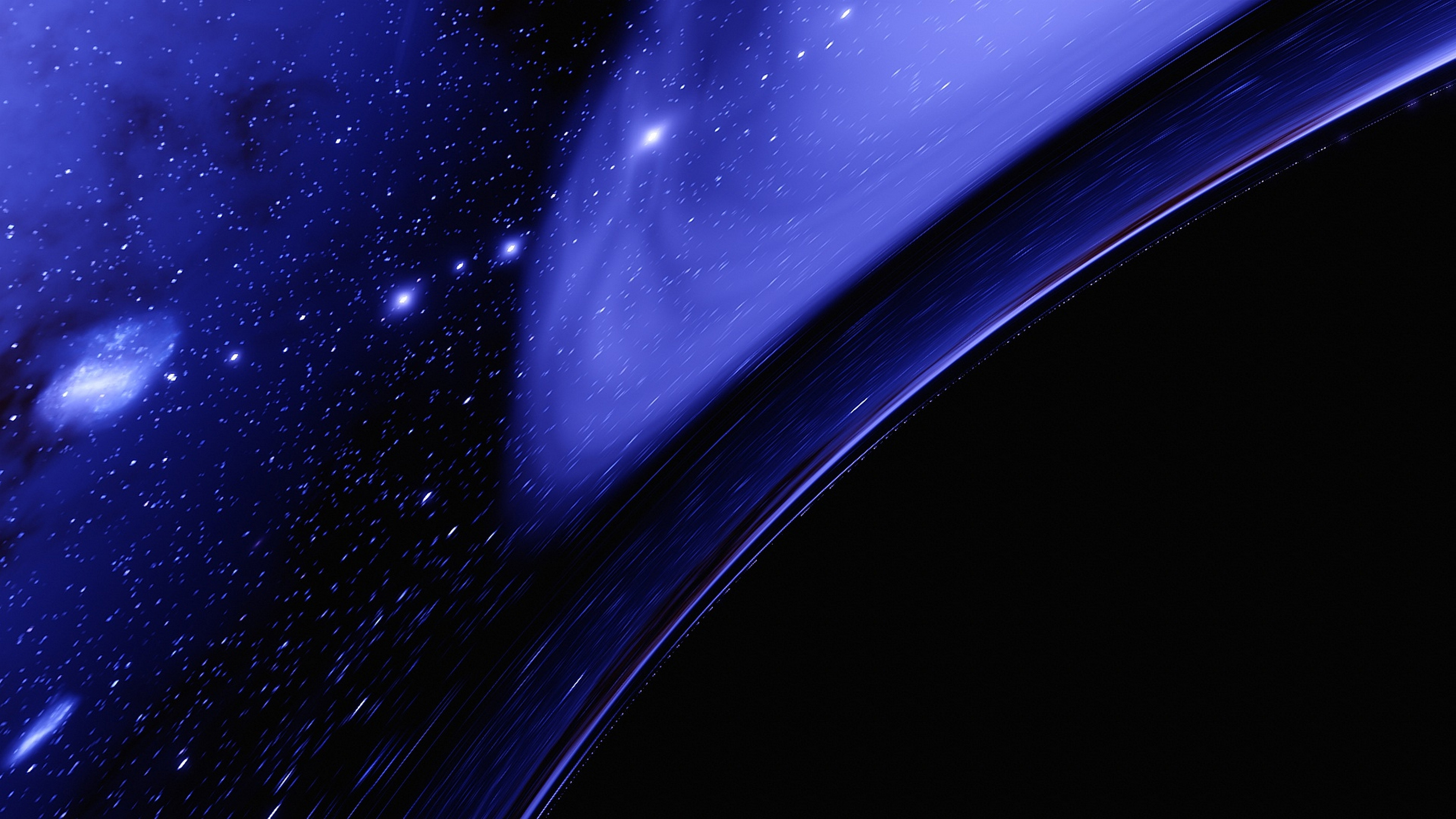Are black holes wormholes?
And can we use them to traverse the universe?

In science fiction, space explorers routinely zip through wormholes in space-time that are connected by two black holes — celestial objects so dense that not even light can escape their clutches.
But are black holes really doorways into wormholes? And would these wormholes look anything like their counterparts in "Star Trek"?
The short answer is probably not, though the mathematics of the universe doesn't quite rule it out.
By themselves, the only thing at the center of a black hole is a singularity — a point of infinite density.
In theory, however, a black hole may be paired with a mirror twin, called a white hole, to form a wormhole. Still, these theoretical wormholes would look nothing like the ones depicted in science fiction — traditional wormholes are predicted to be incredibly unstable, meaning they'd collapse the moment a single particle of matter entered them.
Some physicists predict that a wormhole could become more stable if it was formed from a spinning black hole, but our understanding of what happens in that scenario is murky at best.
Einstein-Rosen bridges
Scientists first discovered black holes not through observations in the universe, but through the mathematics of Einstein's theory of general relativity. Those equations showed that if you crunch down enough matter into a small enough volume, then gravity overwhelms every other force and shrinks the matter down into an infinitely tiny point, known as the singularity.
Black holes are one-way trips. Once someone crosses their boundaries, known as event horizons, they can't ever escape. While black holes were once considered just a trick of Einstein's equations, astronomical observations eventually revealed that black holes do exist in the universe.
But that same mathematics also allows for the exact reverse of a black hole: a white hole. A white hole still has a singularity at its center and an event horizon surrounding it. But instead of falling in and finding it impossible to escape, with a white hole a person could never reach the event horizon from the outside, because it's constantly flinging its contents out into the universe faster than the speed of light.
Connecting the paired singularities of a black hole and a white hole together forms the simplest kind of wormhole, also known as an Einstein-Rosen bridge.
Not very useful

Unfortunately, Einstein-Rosen bridges aren't very useful for traversing the cosmos. For one, the entrance to the wormhole sits behind the event horizon. As a person can't get in on the white hole side, they'd have to fall into a black hole to enter. But once someone crosses an event horizon, they can't ever escape. That means that if you enter the wormhole you're stuck inside for eternity.
The other problem with Einstein-Rosen bridges is their stability. "This bridge is a kind of wormhole, but it is transient: it pinches off before any object can use it to pass from one side to the other. So in this sense one does not really have a wormhole, since one cannot traverse it," Samir Mathur, a physicist at The Ohio State University, told Live Science in an email.
This instability exists because creating a wormhole requires a very precise and careful arrangement of matter. Anything that disturbs this delicate balance — even a single packet of light, or photon — would trigger the instant collapse of the wormhole. The wormhole would tear itself apart like an overstretched rubber band faster than the speed of light, preventing anything from traveling down it.
In addition, physicists largely think white holes don't exist in our universe. Unlike their siblings, white holes are fantastically unstable. According to the math, once even a single bit of matter falls towards them, they instantly explode. So even if white holes naturally formed, they wouldn't last very long.
The combination of the uncertainty of the existence of white holes, the instability of Einstein-Rosen bridges, and the relative non-utility of them means that if wormholes exist, they probably aren't Einstein-Rosen bridges.
A spinning singularity
There may be a way to build a wormhole from a more complicated kind of black hole: take their spinning into account. All black holes spin, but New Zealand mathematician Roy Kerr was the first to solve the math for spinning black holes.
In the center of a rotating black hole, the extreme centrifugal forces spread the point-like singularity into a ring. It may be possible for this "ring singularity" to become an entrance to a wormhole, but once again the problem of stability crops up.
"The singularity of a Kerr hole is surrounded by an 'inner horizon,' which in turn is surrounded by the 'outer horizon.' People believe that the inner horizon is not a stable concept, and that small amounts of infalling matter will completely change the region inside this horizon, and thus also modify the singularity," Mathur said. "The final result of this instability is not clear." The problem is that if matter falls towards the ring singularity, it encounters two competing effects: the immense gravitational pull of the singularity itself, and the extreme centrifugal force of the spin at the center of the black hole, which would act in the opposite direction.
As you can imagine, this is not a very comfortable situation, and things are likely to go haywire very quickly. The situation is so unstable that it may even prevent the formation of the singularity altogether. In this case, many physicists believe that the concept of the "ring singularity" from a spinning black hole will be replaced by a more concrete idea once we gain a better understanding of these objects.
Originally published on Live Science.
Sign up for the Live Science daily newsletter now
Get the world’s most fascinating discoveries delivered straight to your inbox.

Paul M. Sutter is a research professor in astrophysics at SUNY Stony Brook University and the Flatiron Institute in New York City. He regularly appears on TV and podcasts, including "Ask a Spaceman." He is the author of two books, "Your Place in the Universe" and "How to Die in Space," and is a regular contributor to Space.com, Live Science, and more. Paul received his PhD in Physics from the University of Illinois at Urbana-Champaign in 2011, and spent three years at the Paris Institute of Astrophysics, followed by a research fellowship in Trieste, Italy.










